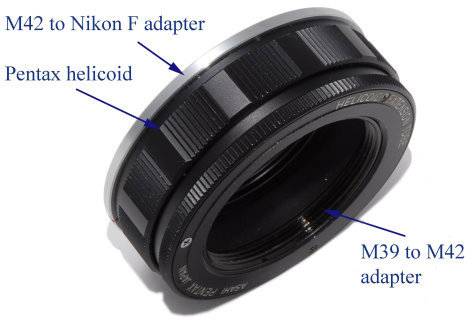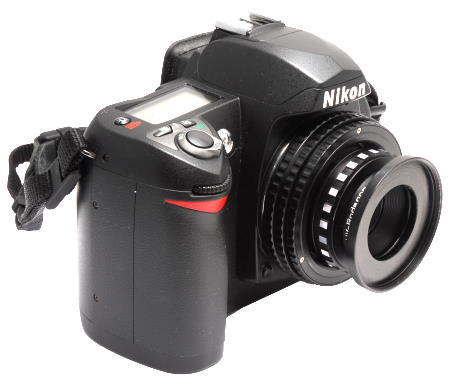Focusing helicoidA focusing helicoid similar to the ones built into general-purpose lenses, but mounted in an extension ring, provides unique opportunities in close-up photography, macro photography and photomacrography. A short focusing helicoid is particularly useful, because neither fixed extension tubes nor bellows are valid alternatives to this (see also here). As far as I know, Nikon never made this type of accessory. Olympus used to make a variable extension ring, but it does not have a helicoid and has a minimum length actually higher than that of most bellows. It could be advantageous for high magnification work in the field, but not for the present purpose. 
Pentax did make a few helicoid rings, including an early model with M42 thread attachments (above picture), which is particularly useful because adapters for M42 lenses to Nikon bodies are now available (from third party firms) with an effective thickness of only 1 mm. This increases the minimum length of a ring by the smallest possible amount.You need an adapter that does not have optical elements. Most of the special-purpose lenses in my possession have either an M39 thread attachment (which can fit into a M42 mount with an adapter that does not increase the minimum thickness of the ring) or a smaller thread. Thus, this helicoid can be adapted to use with Nikon cameras, on which it provides a variable extension range of 19 to 32 mm. The lens does not rotate when the helicoid length changes. This is a desirable property, which sometimes is lacking in other types of focusing helicoid. For practical use, I permanently mounted the Nikon adapter and M39 adapter to the helicoid ring, using red Loctite (an anaerobic adhesive/sealant used industrially to lock screw threads - the red type forms a strong but reversible bond). This prevents the "wrong" threads from loosening when attaching or detaching lens and camera. The above picture shows the focusing helicoid and an EL-Nikkor 70 mm f/4 with a 52 mm filter adapter ring, Nikon AF-1 filter carrier, 52 mm step-down ring and Schuler filter mounted at its front in use on a modified Nikon D70s - a complete setup for UV photography. If desired, M39 extension rings can be mounted between the lens and the helicoid, and/or Nikon extension rings between the helicoid and the camera, to increase the magnification beyond the reach of the helicoid alone. I can focus the above lens to infinity with a small margin left, and an 80 mm f/5.6 (both old and N type) with the helicoid almost totally extended. A fixed extension ring 15 to 18 mm long can be added in this case, to retain the usefulness of the helicoid for focusing at a closer range. Neither model of the EL-Nikkor 63 mm, on the other hand, can focus to infinity with this helicoid. The Pentax helicoid ring discussed above is hard to find. However, there are other, very similar types currently manufactured for use as telescope focusers. Borg markets models of several lengths, as well as types with larger mounts. They can be found at online retailers of telescope equipment. They are quite expensive (roughly like a cheap macro lens), and justified only if you specifically need them (albeit see also below). Helicoid rings made for medium-format cameras (also remarkably expensive) exist as well, and some of them could be modified for use with special-purpose lenses. Some of these rings are so large that they might house a smallish lens and a recessed lens mounting board in their interior, thus - in principle - allowing a zero minimum length. Zörk makes a 26-60 mm helicoid with an M42 mount, quite interesting but twice as expensive as other helicoids. A few years ago, a Hong Kong eBay seller started to offer no-brand focusing helicoids of apparently good quality, in a few different lengths and mount diameters. At the time, I took notice but did not order any, because their prices were excessive (they still are). More recently, another couple of eBay sellers from China and Hong Kong started to offer the same helicoids (not the whole range, but just a few models, and have been increasing their offerings since) at half the price of the first seller. This did make the price about right, and as a consequence I ordered their longest M42 model, with an extension range of 37-90 mm. It is shown above with an EL-Nikkor 105 mm N, 52 mm filter adapter, 16 mm M39 extension ring, M39 to M42 adapter sleeve (totally sunk into the front mount of the helicoid) and M42 to Nikon adapter. This combination allows me to focus the 105 mm from infinity to 0.5x, and therefore it constitutes a "poor man's" equivalent of the UV Nikkor 105 mm for near-UV photography (see here about using EL-Nikkors for this application). The UV Nikkor does have a much more extended range into the UV and IR, but the range covered by the EL-Nikkor 105 mm corresponds roughly to the usable UV range of a modified DSLR without a significant focus-shift, and many lenses perform acceptably in the IR range if one takes focus-shift into account. The 16 mm extension ring between the lens and helicoid allows the lens to focus to infinity when the helicoid is almost completely retracted. Although it would be possible to extend the helicoid for doing so, this would "waste" some of the extension range of the helicoid, and stop short of the 0.5 x magnification. This type of focusing helicoid has a three-segment design with non-rotating front, similar to the Pentax one described above. It extends linearly by turning the focusing ring counterclockwise. It is somewhat difficult to precisely focus near infinity (it extends a little too quickly for this), but focusing becomes easier by using a focusing screen with microprisms. Its inner surfaces are lubricated to allow a set of coaxial sleeves to slide within each other (with a slightly "gritty" feeling of the focusing ring), so you better don't put your fingers inside and don't leave it open to collect dust on a shelf (not that you are expected to do either thing with a helicoid, anyway). It does have three round internal baffles that should be adequate to avoid internal flare. Movements are precise and the front mount does not wobble even at maximum extension. As a whole, this helicoid is much more practical than bellows for field work, and effectively converts this enlarger lens into a multi-purpose system for near-UV (as well as visible) photography. Adding a Nikon PN-11 extension ring does allow focusing between 0.5x and 1x. This helicoid is too long to allow focusing at infinity with lenses 80 mm and shorter. Other models provide extension ranges of 17-32 mm and 27-47 mm (I am still waiting for the latter to become available at a reasonable price, since it would fit right between the two models discussed above). 
Another interesting type of helicoid available from the same sources (above picture) has a larger diameter of the barrel, and a front mount with a 52 mm MA 1 thread. The rear thread is still 42 mm. The 52 mm MA 1 thread is not common in photographic equipment, but seems to be used in telescopes. This helicoid can be modified to provide a range of extension apparently impossible at first sight. While a typical helicoid extends up to roughly twice its minimum length, the one shown above, with an original extension of 16-30 mm, when modified provides a 7.5-21.5 mm extension, i.e., almost three times the minimum extension. This is made possible by epoxying a threaded mount of smaller diameter (in this case, 39 mm) in a recessed position witin the large front mount. This helicoid has an internal sleeve with an annular baffle located conveniently within the front portion of the barrel, ready to seat the new mount, and requires no other modification. In fact, it would be possible to reduce the minimum extension by another 4-5 mm by using a specially formed 39 mm mount. As it is, the front surface of the added mounting flange is recessed by 8.5mm within the 52 mm mount. The front 52 mm thread is still usable after the modification. My main purpose with the above modification is enabling the use of a UV Rodagon 60 mm f/5.6 from infinity to the close-up range. In practice, with the modified helicoid, this lens does focus to infinity with a couple of mm of extension still available before reaching its minimum, and reaches approximately 0.25x at maximum extension. The aperture scale of the UV Rodagon is barely visible, but still usable. If desired, it would be possible to make a new scale and index, and attach them to the still exposed parts of the barrel and aperture ring. The modified helicoid also allows use of an EL-Nikkor 68 mm f/3.5 at infinity. Neither the EL-Nikkor 63 mm f/3.5 nor the 63 mm f/2.8 can focus at infinity with this helicoid, and would need a more extreme modification. There are also old Leica focusing mounts for rangefinder lenses (an example is shown above) that may be modified to serve with modern DSLRs. The one shown above has an extended range, but the lens rotates as the ring extends, and the helicoid needs an M39 to M42 adapter at its front (its front thread is not actually M42 but a proprietary one - however, a short M42 adapter does fit). It may also need a short M39 extension ring at the rear, because of the overhanging design of its rear knurled grip. Other Leica focusing helicoids (especially those with a small, deeply recessed front bayonet) are essentially useless for the present purpose. A focusing helicoid with attachments for M42 lens and Micro 4/3 body is discussed here. In practice, the helicoid rings most likely to be useful are those that allow focusing between infinity and a reasonably short distance with a given lens, which means you may need two or more helicoids for maximum flexibility. Nonetheless, it is always possible to add extension rings between helicoid and camera (which is the quickest way to achieve a higher magnification) or an M39 extension ring between lens and helicoid (like I did with the 105 mm discussed above) for a more permanent use. |